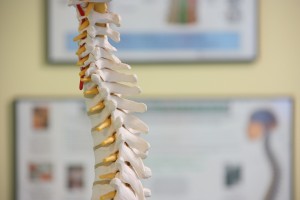
The diagnosis may be termed as a ‘slipped disc’, ‘ruptured disc’, ‘herniated disc’ and ‘disc prolapse’. Unfortunately, healthcare professionals cannot agree on a precise definition, and use these terms interchangeably, which causes confusion. Rather than searching for a precise diagnosis, it is more useful for patients to gain a clear understanding of what may be happening inside their bodies.
So what are discs, what actually happens when they ‘slip’, and can an Osteopath help?
The intervertebral discs are structures found in between vertebrae all the way from the neck to the lower back. They are composed of two parts: a tough outer layer, similar to a tyre, and a soft inner core, of a gel-like consistency. Discs are somewhat pliant, acting as shock absorbers and allowing for spinal curves and flexibility.
Over time, this shock absorbing capability reduces, as the disc wears and loses height due to natural fluid loss. Small cracks appear in the outer layer and, if put under undue strain, the disc can start to be pushed out of shape. If this strain is maintained, the inside gel-like core pushes through the outer layer causing what is called a disc prolapse (‘slipped disc’ is actually a misnomer as the disc doesn’t actually slip out of place). Disc prolapses tend to be most common in the lower back, as it bears the most torque and force on a day to day basis.
The prolapse can press on the spinal nerves directly, or cause an inflammatory response in the area, closing the space where the nerves exit the spine. This can cause pain (known as sciatica if the pain runs down the back of the leg), tingling, numbness, pain or loss of strength in the arms or legs depending on whether the problem is in the neck or low back. In some cases, severe prolapses can press on the spinal cord, which requires urgent medical attention. Osteopaths are trained to recognise any of these signs and act accordingly – referring the patient as appropriate.
Whether the prolapse is mild or severe, sitting, lying, standing, walking, sneezing, coughing and bowel movements can be difficult. Whatever the severity, the damage sustained requires time to repair. Osteopaths encourage this healing process by establishing why the particular disc was the one that had the problem in the first place (possibly trauma or wear and tear for example), and then treating to ensure that the spine is straight and mobile, and the protective spasm around the area is eased. As self-management of a disc problem is key, advice will also be given including postural tips, hot or cold packs and stretching as appropriate, as well as promoting to continue with normal daily activities as much as possible.
The traditional medical approach to a disc problem is often to offer a combination of painkillers and muscles relaxants, which can work in conjunction with Osteopathic treatment to resolve the disc problem more speedily. If the problem persists or there are any worrying symptoms, the patient can be referred back to their GP for further investigations and, if all else fails, on to a specialist if surgery is required.